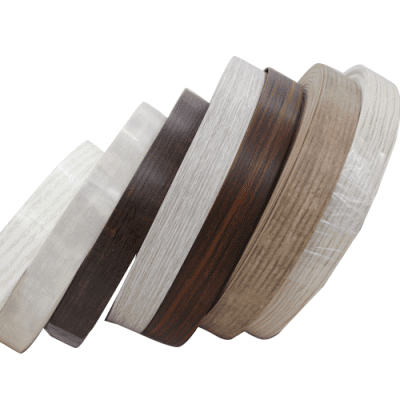The choice between ABS (Acrylonitrile Butadiene Styrene) and PVC (Polyvinyl Chloride) for edge banding depends on various factors, and each material has its own set of advantages and considerations. Here’s a comparison to help you make an informed decision:
ABS Edge Banding:
- Environmentally Friendly:
- ABS is considered more environmentally friendly than PVC, as it doesn’t contain chlorine, a substance associated with environmental concerns in PVC production.
- Impact Resistance:
- ABS is known for its toughness and impact resistance. It is less likely to crack or break upon impact compared to PVC.
- Temperature Resistance:
- ABS generally has better temperature resistance than PVC and is less prone to softening or deforming under high temperatures.
- Flexibility:
- ABS is flexible, making it suitable for applications where the edge banding needs to conform to curved or contoured edges.
- Recyclability:
- ABS is recyclable, contributing to its environmentally friendly profile.
PVC Edge Banding:
- Cost-Effectiveness:
- PVC is often more cost-effective than ABS, making it a budget-friendly option for edge banding.
- Availability:
- PVC edge banding is widely available in a variety of colors, patterns, and finishes, providing a broad range of design options.
- Chemical Resistance:
- PVC is generally more resistant to chemicals compared to ABS, which can be beneficial in certain applications.
- Weather Resistance:
- PVC is known for its resistance to weathering and UV exposure, making it suitable for both indoor and outdoor applications.
- Fire Resistance:
- PVC has inherent fire-resistant properties, making it suitable for applications where fire resistance is a consideration.

- PVC has inherent fire-resistant properties, making it suitable for applications where fire resistance is a consideration.
ABS and PVC Considerations for Both:
- Appearance:
- Both ABS and PVC can offer a wide range of colors and patterns. The choice may depend on the specific aesthetic requirements of the project.
- Adhesive Compatibility:
- Both materials are compatible with various adhesives, but it’s important to follow the manufacturer’s recommendations for adhesive selection.
- Application Requirements:
- Consider the specific requirements of your project, such as impact resistance, flexibility, temperature exposure, and environmental considerations.
In summary, the choice between ABS and PVC for edge banding depends on your specific project requirements and priorities. If environmental friendliness, impact resistance, and temperature resistance are top priorities, ABS may be a preferable choice. If cost-effectiveness, availability, and weather resistance are more critical, PVC may be a suitable option. Always consider the unique characteristics of each material in the context of your project’s needs.


